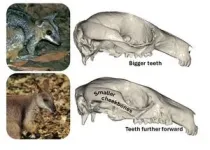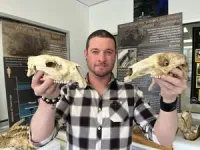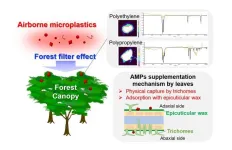(Press-News.org) Australian rock-wallabies are ‘little Napoleons’ when it comes to compensating for small size, packing much more punch into their bite than larger relatives.
Researchers from Flinders University made the discovery while investigating how two dwarf species of rock-wallaby are able to feed themselves on the same kinds of foods as their much larger cousins.
Study leader Dr Rex Mitchell also coined the idea of ‘Little Wallaby Syndrome’ after examining the skulls of dwarf rock-wallabies to discover they can more than compensate for their size.
“We already knew that smaller animals have a harder time eating the same foods as larger ones, simply because their jaws are smaller. For example, a chihuahua wouldn’t be able to chew on a big bone as easily as a German Shepherd,” says Dr Mitchell, from the Morphological Evo-Devo Lab at Flinders University.
“If I were a vegetable, I would not mess with a pygmy rock-wallaby. They totally have ‘Little Wallaby Syndrome’.”
The new study, published today in the Royal Society’s Biology Letters, delves deeper into the marsupials’ superpowers.
Coauthor of the new study, Flinders University Associate Professor in Evolutionary Biology Vera Weisbecker, says some tiny species of rock-wallaby, such as the nabarlek, are able to eat similar foods as relatives that are eight times larger.
“We therefore suspected that something happened in the evolution of their jaws to allow them to stick to these diets,” she says.
To investigate, the researchers scanned the skulls of nearly 400 rock-wallaby skulls, including all 17 species to compare the features of their skulls.
The results confirmed the team’s suspicions. Aside from typical differences in brain and eye size that are usually seen between bigger and smaller animals, there were also differences in the features of the skull used for feeding.
Another co-author Dr Mark Eldridge, from the Australian Museum, adds: “We found clear indicators that both dwarf rock-wallabies have adaptations to harder biting: they had shorter, rounder snouts and teeth positioned at the back of the jaw where they are more effective at harder bites”.
But the researchers also found some surprising differences in the teeth between the dwarfs and larger species. They found that some of the teeth of the dwarfs were much larger, for their size, than any of the bigger species.
“This makes sense, because many animals that need to bite harder into their foods tend to have bigger teeth for their size,” Dr Mitchell says.
As well, dwarf wallabies had another surprise for the researchers: The two dwarf species had different teeth that were the biggest. One species has the biggest molars, while the other has the largest premolars.
These potentially indicate different adaptations to vegetation types. Larger premolars are better at slicing through leaves and twigs of shrubs, while larger molars are better for grinding up grass and other plants that are closer to the ground.
The species with the largest molars, the nabarlek, is the only species of marsupials known to continuously grow new molars throughout its life.
The findings show that dwarf species of rock-wallabies have skulls that are better at biting than larger species.
Dr Mitchell says the findings are important because the functional effects of skull size on skull shape are often ignored because differences in size are not generally considered to be related to feeding adaptations.
But the research team has shown that some differences in the skulls are related to how hard a skull can bite, and that smaller animals need to have harder-biting skulls than larger animals if they want to eat the same kinds of foods.
The article, Functionally mediated cranial allometry evidenced in a genus of rock-wallabies (2024), by D. Rex Mitchell, Sally Potter, Mark DB Eldridge, Meg Martin and Vera Weisbecker has been published in Biology Letters. DOI: 10.1098/rsbl.2024.0045. https://doi.org/10.1098/rsbl.2024.0045 (paper will be online by 11.30am GMT)
Images and captions at the link: Diagram and photos at the link
Specimens for the study were provided by the Museum and Art Gallery NT, WA Museum, SA Museum, Australian Museum, Queensland Museum and the Australian National Wildlife Collection (https://ror.org/059mabc80)
END
Small Aussie mammal's bite 'packs a punch'
Rock-wallabies are ‘little Napoleons’ when compensating for their small size
2024-03-27
ELSE PRESS RELEASES FROM THIS DATE:
Advancing towards sustainability: turning carbon dioxide and water into acetylene
2024-03-27
Reaching sustainability is one of humanity’s most pressing challenges today—and also one of the hardest. To minimize our impact on the environment and start reverting the damage humanity has already caused, striving to achieve carbon neutrality in as many economic activities as possible is paramount. Unfortunately, the synthesis of many important chemicals still causes high carbon emissions.
Such is the case of acetylene (C2H2), an essential hydrocarbon with a plethora of applications. This highly ...
Twist of groundwater contaminants
2024-03-27
In recent years, the world has been experiencing floods and droughts as extreme rainfall events have become more frequent due to climate change. For this reason, securing stable water resources throughout the year has become a national responsibility called 'water security', and 'Aquifer Storage Recovery (ASR)', which stores water in the form of groundwater in the ground when water resources are available and withdraws it when needed, is attracting attention as an effective water resource management technique.
The Korea Institute of Science and Technology (KIST) announced that a team of Dr. Seunghak ...
Scientists extract genetic secrets from 4,000-year-old teeth to illuminate the impact of changing human diets over the centuries
2024-03-27
Researchers at Trinity College Dublin have recovered remarkably preserved microbiomes from two teeth dating back 4,000 years, found in an Irish limestone cave. Genetic analyses of these microbiomes reveal major changes in the oral microenvironment from the Bronze Age to today. The teeth both belonged to the same male individual and also provided a snapshot of his oral health.
The study, carried out in collaboration with archaeologists from the Atlantic Technological University and University ...
Treatment of advanced non-small cell lung cancer with driver mutations
2024-03-27
Lung cancer is the leading cause of cancer-related death worldwide. Improved understanding of driver mutations of non-small cell lung cancer (NSCLC) has led to more biomarker-directed treatment for patients with advanced stages. The expanding number of drugs targeting these driver mutations offers more opportunity to improve patient’s survival benefit.
To date, NSCLCs, especially those with non-squamous histology, are recommended for testing epidermal growth factor receptor (EGFR) mutations, anaplastic lymphoma kinase (ALK) gene rearrangements, ROS proto-oncogene receptor tyrosine kinase 1 (ROS-1) rearrangements, B-raf proto-oncogene (BRAF) mutations, rearranged during transfection ...
UK rabbit owners can recognize pain in their pets, study finds
2024-03-27
Rabbits are popular family pets, with around 1.5 million* in the UK and it is important that owners can recognise when their animal is in pain, and know when to seek help to protect their rabbit’s welfare. New research by the University of Bristol Veterinary School has found the majority of rabbit owners could list signs of pain and could mostly identify pain-free rabbits and those in severe pain, but many lacked knowledge of the subtler sign of pain.
The study, published in BMC Veterinary Research today [27 March], provides the first insight into how rabbit owners identify pain and their general ability to apply this knowledge to detect pain ...
World's first demonstration that forests trap airborne microplastics
2024-03-27
A research group led by Japan Women’s University finds that airborne microplastics adsorb to the epicuticular wax on the surface of forest canopy leaves, and that forests may act as terrestrial sinks for airborne microplastics
Tokyo, Japan – Think of microplastics, and you might think of the ones accumulating in the world’s oceans. However, they are also filling the sky and the air we breathe. Now, it has been discovered that forests might be acting as a sink for these airborne microplastics, offering humanity yet another ...
How will you age? World-leading Dunedin Study launches next phase
2024-03-27
The world-leading Dunedin Study is set to launch its age 52 assessments, delving into an understudied but important period of life and time of change.
The Dunedin Multidisciplinary Health and Development Study is a longitudinal study that follows the lives of 1037 babies born in Queen Mary Maternity Hospital between 1 April 1972 and 31 March 1973. It is the most detailed study of human health and development in the world.
Members have been assessed regularly throughout their lives, most recently at age 45.
Study Director, Research Professor Moana Theodore is incredibly excited ...
Opportunistic emergency department stop smoking prompt helps smokers quit
2024-03-27
An opportunistic emergency department stop smoking prompt, comprising brief advice by a trained professional, an e-cigarette starter kit, and referral to local stop smoking services can help smokers quit, with a significant proportion of them still not smoking 6 months later, finds research published online in Emergency Medicine Journal.
Some 6.4 million people in the UK still haven’t stubbed out for good, and of the large numbers of people attending emergency departments, a substantial proportion are more likely to be smokers and have poorer overall health, explain ...
Consistently exercising 2-3 times a week over the long term linked to lower current insomnia risk
2024-03-27
Consistently exercising 2-3 times a week over the long term is linked to a lower current risk of insomnia as well as the ability to clock up the recommended 6-9 hours of shut eye every night, suggests an international 10-year study published in the open access journal BMJ Open.
Regular exercise is associated with better overall health, and several studies have suggested that physical activity promotes better quality sleep and may improve symptoms of chronic insomnia, note the researchers.
But it’s not entirely clear how much gender, age, weight (BMI), overall fitness, general health and exercise ...
Handing out vapes in A&E helps smokers quit
2024-03-27
Peer reviewed – randomised controlled trial - humans
Giving out free e-cigarette starter packs in hospital emergency departments to people who smoke helps more people quit – according to research from the University of East Anglia.
The trial, funded by the National Institute for Health and Care Research (NIHR), offered advice, an e-cigarette starter pack and referral to stop smoking services to people attending A&E for any reason, to help them to stop smoking.
Six months later, almost one in four people given the starter packs said they had quit smoking. And those who received ...
LAST 30 PRESS RELEASES:
Modulating key interaction prevents virus from entering cells
Project explores barriers to NHS career progression facing international medical graduates
Jeonbuk National University researchers explore the impact of different seasonings on the flavor perception of Doenjang soup
Two Keck Medicine of USC Hospitals named Leapfrog Top Teaching Hospitals
World-first discovery uncovers how glioblastoma tumours dodge chemotherapy, potentially opening the door to new treatments
A fatal mix-up: How certain gut bacteria drive multiple sclerosis
New AI tool identifies not just genetic mutations, but the diseases they may cause
Deep-learning model predicts how fruit flies form, cell by cell
Combination pills for high blood pressure may simplify treatment, improve long-term health
Immune system keeps mucosal fungi in check
Neurons within the brain use simple rules to localize genetic messages
Electrodes created using light
Second-hand gift-giving is a well-deliberated decision
How human interaction drove evolution to make bears less aggressive
National Poll: Few parents offer teens guidance on healthy eating during holiday season
Cannabis derivatives could provide new ovarian cancer treatments
Raising strong yeast as a petroleum substitute
Clues to the origin of hot Jupiters hidden in their orbits
Canada’s reduced pledge to Global Fund will impact domestic health
1 in 4 children with major traumatic injuries not cared for in pediatric trauma centres
Duke and Duke-NUS’ joint cross-population research to uncover "East-West" differences in disease and care
Scientists to ‘spy’ on cancer- immune cell interactions using quantum technology breakthrough
Tech savvy users have most digital concerns
Making lighter work of calculating fluid and heat flow
Normalizing blood sugar can halve heart attack risk
Lowering blood sugar cuts heart attack risk in people with prediabetes
Study links genetic variants to risk of blinding eye disease in premature infants
Non-opioid ‘pain sponge’ therapy halts cartilage degeneration and relieves chronic pain
AI can pick up cultural values by mimicking how kids learn
China’s ecological redlines offer fast track to 30 x 30 global conservation goal
[Press-News.org] Small Aussie mammal's bite 'packs a punch'Rock-wallabies are ‘little Napoleons’ when compensating for their small size







